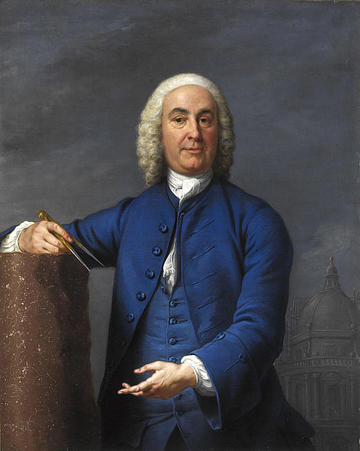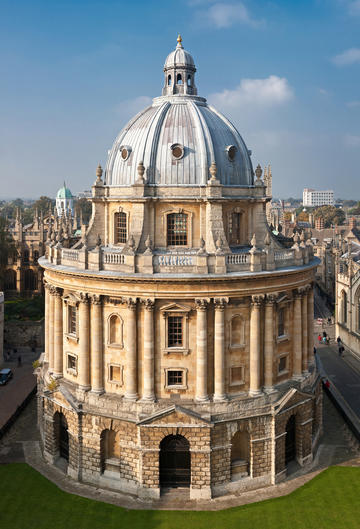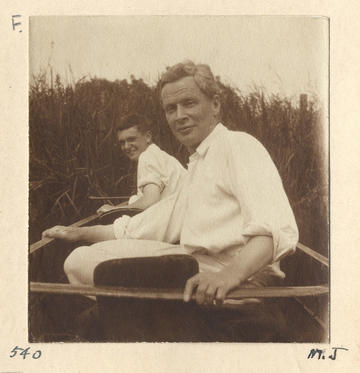Religious tests in Oxford, an exclusively Church of England institution since the 1560s, were only abolished in 1871, but the University’s most recognisable building, the Radcliffe Camera was designed by a Roman Catholic, and recipient of an honorary Oxford MA, who was already a graduate of a British University. The architect James Gibbs (1682-1754) studied for an MA degree in his late teens at Marischal College, in his native city of Aberdeen, before going on to brief clerical studies and extended architectural studies in Rome. In remote Aberdeen, where Catholics and Episcopalians had arrived at an effective system of pragmatic toleration, it was wholly possible for a Catholic to take a degree without oaths or affirmations. Thus Gibbs became the only alumnus of the Pontifical Scots College in Rome also to hold an honorary degree from Oxford, and both Oxford and the theoretically-illegal Catholic mission in Scotland were remembered in his will.

James Gibbs, 1682-1754.
Another Aberdonian, Fr Charles Leslie SJ, whose cousins were a far-flung cosmopolitan family of successful soldiers of fortune, ennobled as Counts of the Austrian Empire, built the first Catholic chapel in Oxford since the Reformation. St Ignatius’s is in St Clement’s therefore theoretically just outside the old City boundaries. This simple classical building, much like the small Catholic chapels in upland Aberdeenshire and Banffshire supported by the bequests in James Gibbs’s will, was seen as such a threat to the good order of the university that Proctors and their ‘Bulldog’ enforcers were stationed outside it on Sunday to maintain the rule that it was out of bounds to undergraduates, except to the few, like the poet Gerard Manley Hopkins, who had converted in the course of their undergraduate careers.

The Radcliffe Camera, designed by the Catholic architect James Gibbs.
Another member of a cosmopolitan northern Scottish family, Francis Fortescue Urquhart (1868-1934) of Balliol, was the first Catholic Oxford tutorial fellow since the Reformation. He was born near Geneva, and was mostly resident in Switzerland. His father was a diplomat and his mother an aristocratic convert to Catholicism. What is remarkable about ‘Sligger’ Urquhart, is that he completed the whole course of studies approved by the English hierarchy for a Roman Catholic before he ever came to Oxford. His preparatory school and public school were both Jesuit-run: Hodder and Beaumont College. He then undertook the only form of higher study officially sanctioned before 1896, which was to join the ‘Gentlemen Philosophers’ of Stonyhurst, a university course at the Jesuit college in Lancashire, with an international student body (including at one point the future Irish revolutionary Joseph Mary Plunkett (1887-1916). Like many Stonyhurst Philosophers, ‘Sligger’ took an external London degree: his was in Classics. Thus his university education was technically complete before he studied at Balliol from 1890-94.

Francis Fortescue Urquhart, 1868–1934.
It can be conjectured that he thought of himself as exempted from the Catholic hierarchy’s prohibition by simple fact of nationality. Though there never appears to have been any public proclamation one way or another, the (ecclesiastically wholly separate) Scottish hierarchy never objected to Scottish Catholics, from the time of James Gibbs onwards, studying at the tolerant colleges of the University of Aberdeen.
‘Sligger’ became an Oxford institution, viciously lampooned in 1925 by the young Evelyn Waugh (himself later a most zealous Catholic convert) in the amateur film The Scarlet Woman whose plot centres on the schemes of the Dean of Balliol to convert the Prince of Wales to Catholicism. Among Urquhart’s numerous legacies to Balliol is a sumptuous silver-gilt altar frontal, an object which might look more at home in a basilica in the Iberian world, than in a gothic-revival chapel in Oxford, a fitting memorial to the first Catholic tutorial fellow since the Reformation.
Peter Davidson, Senior Research Fellow in Renaissance and Baroque Studies and Curator of the Campion Hall Collection.